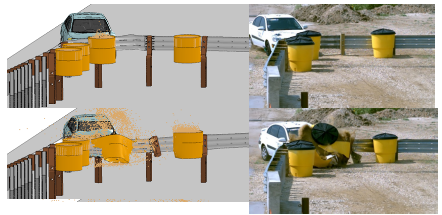Using HPRC to Analyze and Design Road Side Safety Hardware: Current Status and Future Outlook

TTI Research Scientist
Roadside Safety Program
Texas A&M Transportation Institute
Texas A&M University System
Location: Student Computing Center (SCC) - Room 4.210F
Time: October 10, 2016 - 2:30-3:30pm
Abstract
As an integral part of engineering safer roads, road side safety devices passively interact with errant vehicles to redirect them safely back to the road or bring them to a safe and controlled stop. These devices take the form of crash cushions, cable barriers, concrete barriers, steel barriers, guard rails, guardrail terminals and others. However, before those devices are placed on the roadways, they have to be evaluated under objective test conditions. Given that possible combinations of impact speeds, impact angles, vehicle characteristics and roadway characteristics are infinite, it is formidable to design roadside safety hardware for all those combination. Thus a “Practical Worse Case” philosophy derived from crash data analyses is followed to determine such impact conditions. In the USA, the evaluation methodologies are established in the National Cooperative Highway Research Program (NCHRP) Report 350 which is now superseded by Manual for Assessing Safety Hardware (MASH) guidelines. In the early parts of this presentation I will demonstrate testing conditions and criteria for quantifying the device as crashworthy under MASH for some of the common road safety devices. Then, I will talk about using HPRC to analyze and design roadside safety hardware and their subsequent crash tests.

Predictive simulation (left) and subsequent crash test (right) of a 1100 kg vehicle impacting a curved radius at 100km/hr
Speaker's Bio
Dr. Abu-Odeh has nearly 20 years of experience with TTI and has been actively involved in finite element modeling and simulation of vehicular impacts with roadside safety structures using LS-DYNA. Recent projects include the successful development of a guardrail on slope, sign mounts hardware on barriers, median W-Beam barrier and short radius treatment for intersecting roadways. All of these designs were developed and analyzed through nonlinear finite methodology and subsequently passed the MASH full scale crash tests. Dr. Abu-Odeh has broad experience in numerical simulation of structural systems based on formal course work of finite element analysis of structures and extensive use of finite element codes such as LS-DYNA , ABAQUS and point cloud codes such as Geomagic.
